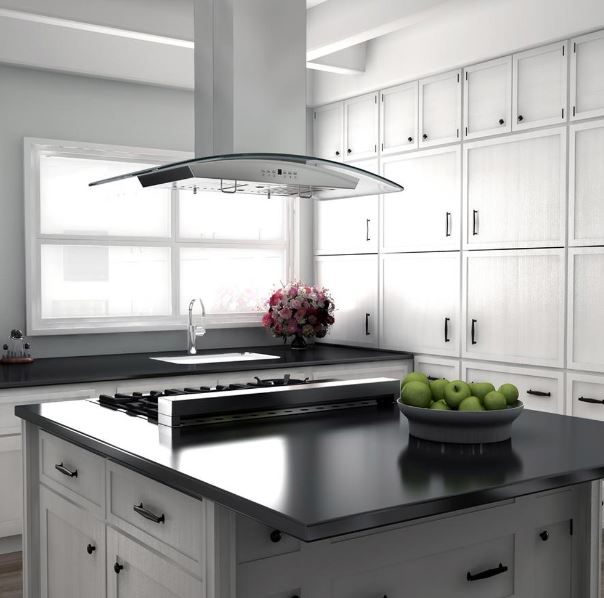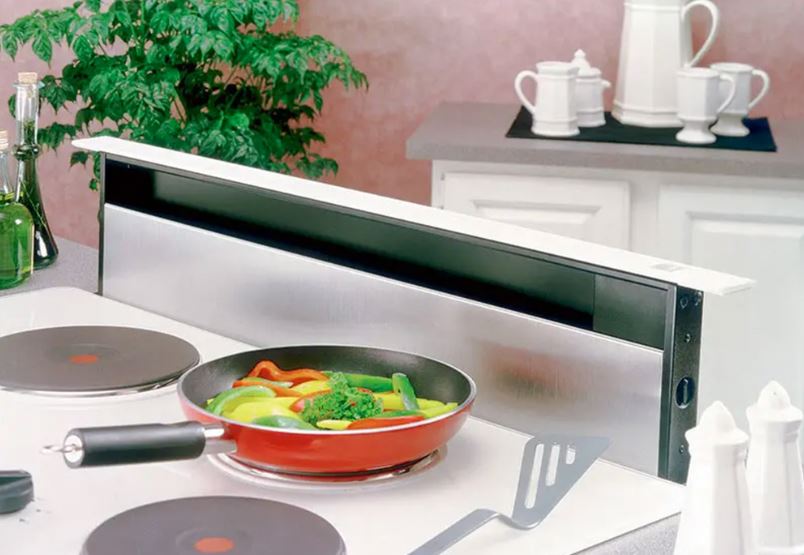If you happen to be looking for a new range hood but are unsure of where to begin, it can help to take a look at the different types of range hoods available. Whether you’re a first-time buyer or a seasoned remodeler (or anywhere in-between!), it can help to know what’s on the market and what would work best for you and your kitchen space. If you’re looking for product recommendations, take a peek at HealthyKitchen101’s recommendations for the top range hood picks for 2019.
Range hoods (also known as vent hoods, kitchen hoods, exhaust hoods) come in all sorts of shapes and sizes. All range hoods aim to improve air quality in the kitchen but there are differences in design and set up. So what are the different types?
Ducted and Ductless Range Hoods
The biggest factor that affects what type of range hood will work for you is the ducting. Do your kitchen space, design, and budget allow or necessitate that you get a hood with ducting that vents to the outside or one that is ductless, that filters and recirculates the air? There are pros and cons to each option:
Ducted
Ducted range hoods draw the air out of the kitchen, helping improve the quality of indoor air by extracting pollutants and odors. Ducted ventilation is definitely more efficient (if not the most efficient) but considering the purchase price of ducted units and their installation cost, it’s definitely more expensive.
To run ducted hoods, your kitchen will need some ductwork. It’s not DIY-friendly to run your own ducts and we recommend hiring a certified technician to help. You may also have to sacrifice an upper cabinet for the ducts, so get ready for that.
The noise level of a typical model is around 60 dB (normal conversations), so they are not as quiet as many manufacturers like to claim. Only more advanced models with a sound insulation system may see a difference.
Ductless
Ductless range hoods avoid the cost of installing ductwork. They draw in smoke, fumes, and steam, run them through grease traps and charcoal filters, then release the filtered air back to the room. More moisture and pollutants remain in the air, but it still improves air quality around the cooktop compared with no hood at all.
The lack of ductwork makes these hoods more flexible in terms of where it can be. They take up less space than ducted hoods and you may get to keep the upper compartment, too. It’s recommended to open windows and doors if possible to help with the ventilation.
Convertible
Convertible range hoods can be installed with or without ducting. They can be set to vent air outside or to filter and recirculate it. They are especially convenient if you want to introduce ducting and switch from ductless to ducted at a future date or when it’s cold and you can’t afford to lose any ounce of warmth by running a ducted hood.
Most of the time, convertible units come as ducted by default and can be modified later to operate in a ductless kitchen by using compatible charcoal filters. Some manufacturers may use the term “convertible” for models with multiple outlet configurations (top or rear) so be careful.
Mounting of Range Hoods
Range hoods are also categorized by their methods of mounting. The most popular types include wall mount, island mount, and under cabinet hoods.
Wall Mount

Wall mount range hoods draw the air in and vent it via a chimney and ductwork to the outside. They can be installed with the chimney showing or covered (I personally think the exposed look is more appealing). Wall mounts are often used in commercial kitchens too and are generally thought of as the most effective design for kitchen ventilation.
They do take up a significant portion of the wall and if you’re already limited on space, that’s not ideal, and since they need ductwork, their setup is more complicated and may require the removal of one of your overhead cupboards. However, being larger also means they have more capacity for power.
Island Mount (Ceiling Mount)

Cooktops located in kitchen islands often use island range hoods. They are mounted on the ceiling (as opposed to wall mounts) and usually wider than the range top to help capture more fumes. In a traditional wall-mounted setup, the wall and cabinets surrounding the hood help to funnel fumes up to the capture zone, but island cooking does not enable that, so a larger catch area is recommended.
Again, there’s the question of personal preference: some people love the bold visuals of having a hood right in the middle of the room, while others find it obtrusive. There’s also the concern of weight support as these hoods hang entirely on the ceiling.
Under Cabinet

Under cabinet hoods are mounted under the cabinets above your range. They can be vented or non-vented, depending on what you have available. They are mostly seen in apartments and houses with smaller kitchens because of their space-saving dimensions.
If you choose to install one without ductwork, it leaves precious cabinet space available and cut down the installation process greatly, but keep in mind that air filtering and cleaning will always be more effective with venting.
Downdraft

Downdraft hood ventilation systems draw the air across the cooktop, down and out. It is less of a hood and more of a helping vent. They are generally installed right behind your cooktop (though some cooktops have them built-in), and often have a telescopic feature, allowing them to come up when in use and go back down when not.
This is a good alternative if you are unable to install a hood over the cooktop; it still removes air pollutants and is close to the cooking surface. However, warm air naturally rises, so it’s not able to capture as much as an updraft hood would. It would also struggle with taller cooking apparatus, such as a stockpot.



